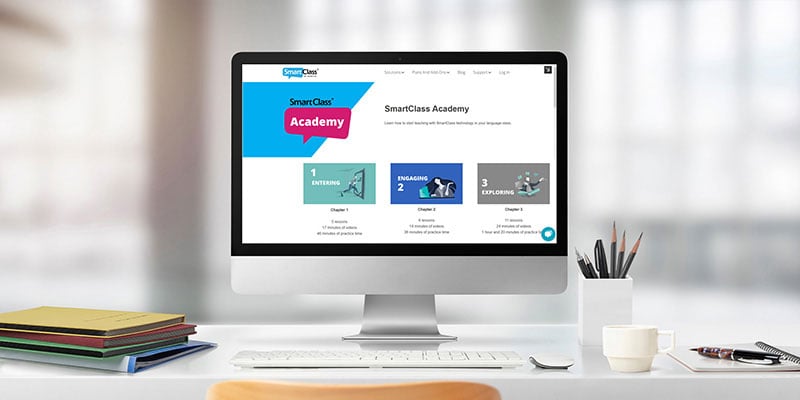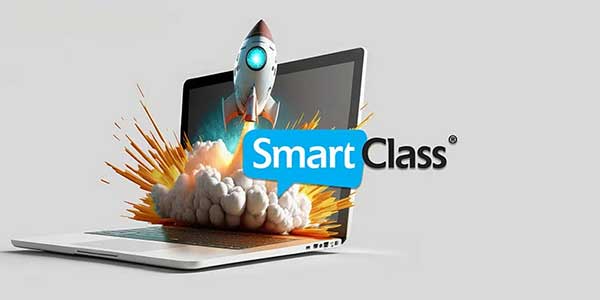A student book with a digital platform and interactive ESL curriculum
As a teacher, I both hated and loved student workbooks. I liked that there were activities already set up for me that I could easily give my students to do (in class or at home). However, I also felt like I was using the workbook to fill time and it didn't help my students speak, be comfortable, and practice pronunciation in the target language.
With SmartClass, you get a student book AND an interactive platform that grades activities for you and allows your students to practice speaking, listening and pronunciation anywhere at any time!
1. Why do you need a student book?
The original plan for our “Let’s Talk! English” (LTE) content was based on our experience and struggles as language teachers. We didn’t want schools to have to pay for textbooks, workbooks, printing, paper, supplemental materials and and and. We wanted a solution for everyone that was affordable and meaningful so that teachers could focus on what's important: the students.
That’s why we created the entire curriculum within the SmartClass software, so teachers could assign an activity to their students within seconds. No more printing or collecting. Everything is within the software (and half of the activities are auto-graded, who doesn’t like that, right?)
But, not everyone is ready to go completely paperless quite yet. Even me! I could not simply have an e-book for teaching. That’s why we have a teacher handbook. It’s just different from having something real, in your hands, in front of you. Something to quickly look something up, flip a page, and get an overview.
What about the students though?
We don't want to go back to the old-fashioned workbook for students. We have way too many meaningful activities that focus on listening and speaking. We can’t transfer those into a workbook. And simply deleting all those activities, deleting the answers in the written exercises, didn’t make much sense either, because then, how are we different from everyone else? And why would you need our software then? The whole point of it is to make the teachers’ job easier by having 50% auto-graded activities and by engaging students to speak, record themselves, and practice pronunciation.
Of course, we think we found a good compromise between software and student books, but you be the judge!

2. What’s in our LTE student book?
To keep all the benefits of the software and make the student book a useful tool for students, we decided to make it more like a resource book. Every chapter of our full ESL/EFL curriculum called "Let's Talk! English" (LTE) has vocabulary lists, grammar charts, reading texts, conversation worksheets, games, self-assessments, and projects.
So that's what we put into our student book.
Please take a look, and let us know what you think in the comments below!
1. The full vocabulary lists and transition sheets
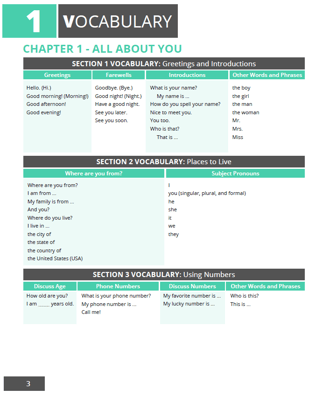
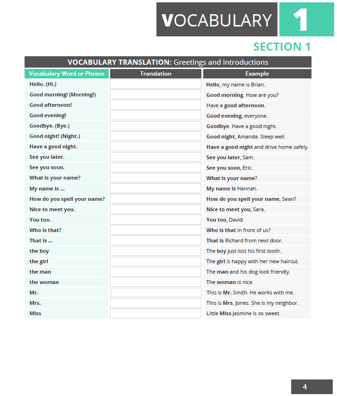
Having a place to review vocabulary and write down translations is crucial to successful learning and studying. That's why we have included the full vocabulary lists for each chapter, as well as a translation sheet of all words and phrases for each section.
2. Grammar charts and QR codes for our grammar videos
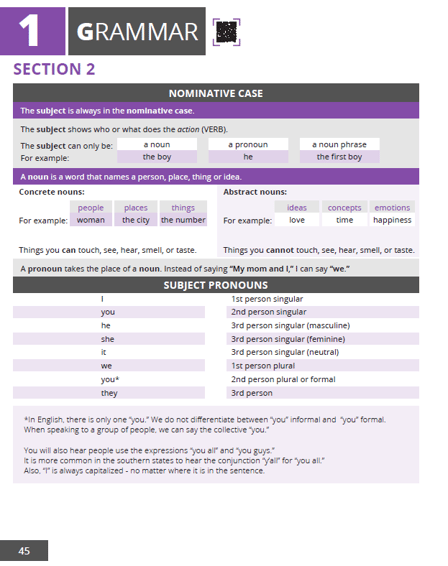
Teaching grammar can be painful and not all students respond to your teaching style. In our "Let's Talk! English" student book, we have not only included the full grammar charts that you will use to teach your students, but we also left some room for students to take notes and write down comments.
Best of all: Almost every grammar chart comes with a QR to an explanatory grammar video. Chelsea, one of our teachers, explains the grammar concept with lots of examples, rules, and exceptions to those. Your students can watch these videos at home to review, study, or even in class if you have exhausted all possible ways YOU would teach a particular grammar topic.
3. Reading texts

Since our platform doesn't have markup capabilities for students, we felt strongly about including the full reading texts of each section in our LTE student book. That way, students can really work with the text, write down translations if needed, highlight passages, underline the correct answers and so much more. But remember, the activities that go along with those texts are integrated into our platform, so you still get the benefits of automatically graded activities and lots of speaking opportunities for your students.
4. Conversation activities and game sheets
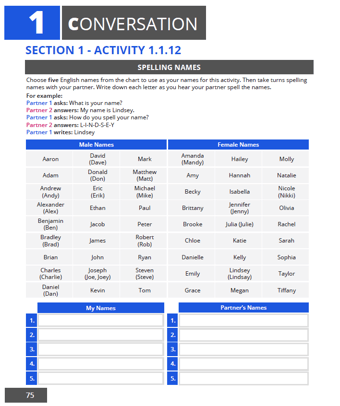
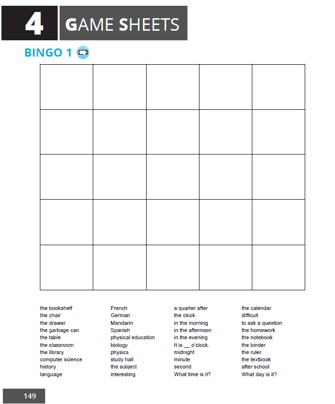
These are probably the kind of worksheets teachers print and have to look for or create the most. So obviously we had to include those in our student book as well. For you, teachers, this means no more storing, creating, printing, or distributing worksheets or game sheets anymore. Yay!
For your students, it makes it easy to access them, if they are part of their student book, without needing another binder or folder to keep them.
5. Self-evaluation rubrics and projects

We highly believe in helping students help themselves and including them in their learning process. That's why we developed these self-evaluations after each chapter before we provide a complete review and assessment section.
We also included projects that summarize the chapter concepts and give students a hands-on project to show what they have learned.
3. Summary
We believe our student book includes the most valuable resources to aid you in your language teaching, complementing our full ESL/EFL curriculum for English, and still offering the benefits of a digital curriculum with automatically graded activities and lots and lots of speaking and listening opportunities for students. Here is a brief summary of the benefits of our LTE student book for you, your students, and your school:
Students can now:
- write in something
- take notes
- highlight words
- use lists and translation sheets to study vocabulary
- review grammar easily with their notes and videos
- have conversation and game sheets handy and ready for class
- keep everything organized in one book, not individual printouts
- Benefits "Kinesthetic/Hands-on" and "Read/Write" learner types.
- Student books can be taken home to study/work with (especially helpful when the internet or technology aren't available at home)
Teachers:
- don’t have to find files of worksheets
- don’t need to print out anything anymore
- don’t need students to have a separate binder for worksheets and notes
- have something to point students to to review concepts and study for tests
- can assign homework (vocab lists, grammar review, prepare readings and conversations, self-assessment, etc) WITHOUT internet/technology
- can leverage using our LTE Content as it has printed resources for teachers AND students
We are curious to hear from you, though! Why do/don't you use student books in your language classroom? Where do you see the benefits or disadvantages of student books? Which books do you find helpful or useless? Leave us a comment and get the conversation started!
